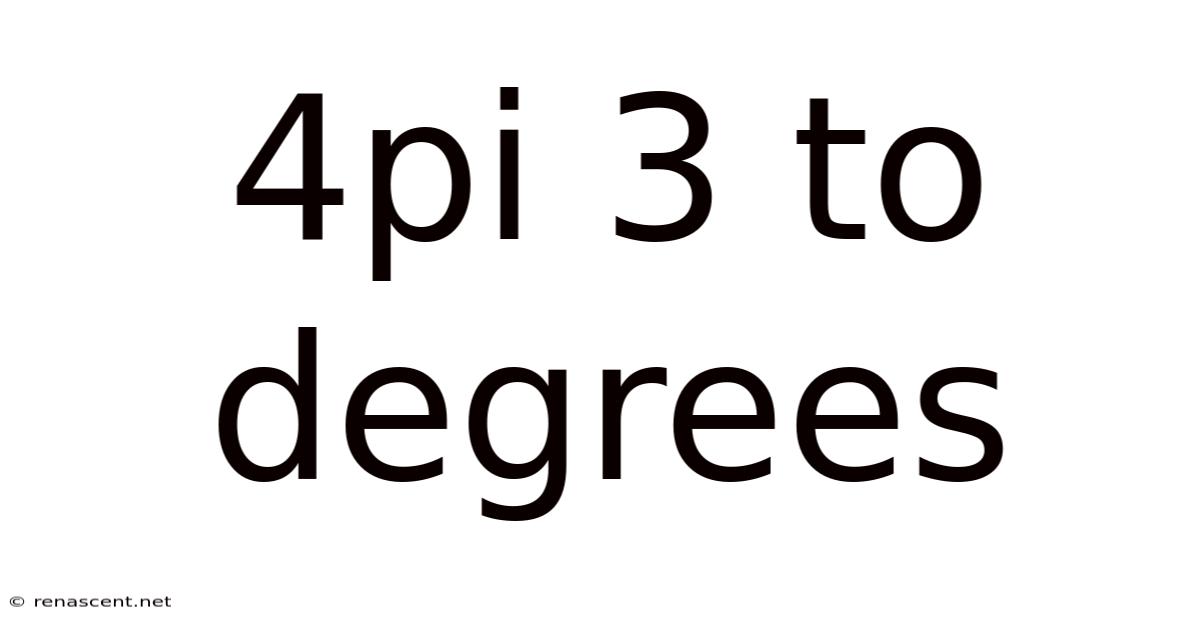4pi 3 To Degrees
renascent
Sep 24, 2025 · 4 min read

Table of Contents
Understanding the Conversion: 4π/3 Radians to Degrees
Converting between radians and degrees is a fundamental skill in mathematics and various scientific fields. This article will delve deep into the process of converting 4π/3 radians to degrees, explaining the underlying principles, providing a step-by-step guide, and exploring the broader context of angular measurement. We'll also address common misconceptions and answer frequently asked questions to ensure a complete understanding of this important concept.
Introduction: Radians and Degrees – A Tale of Two Measurements
Angles are measured using two primary units: degrees and radians. Degrees, a familiar system, divides a full circle into 360 equal parts. Radians, on the other hand, are based on the radius of a circle. One radian is defined as the angle subtended at the center of a circle by an arc equal in length to the radius of the circle. This seemingly abstract definition has significant implications in calculus and higher-level mathematics, as it simplifies many formulas and calculations. Understanding the relationship between these two systems is crucial for seamless transitions between different mathematical contexts. This article focuses specifically on converting the radian measure 4π/3 to its equivalent in degrees.
Step-by-Step Conversion: From Radians to Degrees
The fundamental conversion factor between radians and degrees stems from the fact that a full circle encompasses 2π radians and 360 degrees. Therefore, the conversion factor is:
180 degrees = π radians
To convert 4π/3 radians to degrees, we can set up a proportion:
(4π/3 radians) * (180 degrees / π radians) = x degrees
Notice how we've multiplied the radian measure by the conversion factor, ensuring that the 'radians' unit cancels out, leaving us with the desired 'degrees' unit.
Now let's solve for x:
-
Cancel out π: The π in the numerator and denominator cancel each other out.
-
Simplify the fraction: (4/3) * 180 degrees = x degrees
-
Perform the multiplication: (4/3) * 180 = 240
Therefore, 4π/3 radians is equal to 240 degrees.
Visualizing the Angle: A Geometric Perspective
Imagine a circle. A full rotation around the circle represents 360 degrees or 2π radians. Half a rotation is 180 degrees or π radians. Now, consider 4π/3 radians. This represents an angle that is (4/3) of a half-circle or (4/3)π radians. Since π radians is 180 degrees, (4/3)π radians is (4/3) * 180 degrees = 240 degrees.
This angle is located in the third quadrant of the Cartesian coordinate system, meaning both its x and y coordinates are negative. Understanding the quadrant location helps in visualizing the angle and its trigonometric functions (sine, cosine, and tangent).
The Significance of 4π/3 Radians (240 Degrees) in Trigonometry and Calculus
The angle 4π/3 radians (or 240 degrees) holds specific importance in trigonometry and calculus. It's a key angle for understanding the behavior of trigonometric functions and their periodicity. Here's why:
-
Trigonometric Function Values: At 240 degrees, we find specific values for sine, cosine, and tangent. The sine of 240 degrees is -√3/2, the cosine is -1/2, and the tangent is √3. These values are crucial in solving various trigonometric equations and problems.
-
Unit Circle: The unit circle, a fundamental concept in trigonometry, provides a visual representation of trigonometric functions for various angles. The point corresponding to 240 degrees on the unit circle will have coordinates (-1/2, -√3/2).
-
Calculus Applications: In calculus, understanding angles in radians is essential for working with derivatives and integrals involving trigonometric functions. The radian measure simplifies many formulas and calculations.
Addressing Common Misconceptions and Challenges
One common mistake when converting radians to degrees is forgetting the correct conversion factor or incorrectly manipulating the units. Always ensure you are multiplying by 180/π and not π/180, which would yield an incorrect result. Another area of confusion is understanding the negative angles. Negative angles are measured clockwise from the positive x-axis, while positive angles are measured counterclockwise. Understanding this convention is crucial for accurately representing angles.
Frequently Asked Questions (FAQ)
-
Q: Why are radians preferred in calculus and higher mathematics?
-
A: Radians simplify many formulas in calculus, particularly those involving derivatives and integrals of trigonometric functions. The use of radians leads to more elegant and concise mathematical expressions.
-
Q: Can I convert degrees to radians using the same principle?
-
A: Absolutely! The conversion factor is simply reversed: π radians / 180 degrees. To convert degrees to radians, you would multiply the degree measure by π/180.
-
Q: What are some real-world applications of radian measure?
-
A: Radian measure is crucial in physics, engineering, and computer graphics. It's used in calculating rotational speed, angular acceleration, and representing circular motion.
Conclusion: Mastering Radian-to-Degree Conversions
The ability to smoothly convert between radians and degrees is a fundamental skill in mathematics and related fields. This article provided a thorough explanation of converting 4π/3 radians to 240 degrees, elucidated the underlying principles, and addressed common misconceptions. By mastering this conversion, you'll unlock a deeper understanding of angular measurement and its various applications in diverse fields of study and practice. Remember the key conversion factor: 180 degrees = π radians, and always double-check your calculations to ensure accuracy. This seemingly simple conversion opens doors to a wider comprehension of mathematics and the world around us.
Latest Posts
Latest Posts
-
10 Percent Of 350
Sep 24, 2025
-
68 Lbs To Kg
Sep 24, 2025
-
4 Divided By 360
Sep 24, 2025
-
6 2 Miles To Kilometers
Sep 24, 2025
-
38 1 C To F
Sep 24, 2025
Related Post
Thank you for visiting our website which covers about 4pi 3 To Degrees . We hope the information provided has been useful to you. Feel free to contact us if you have any questions or need further assistance. See you next time and don't miss to bookmark.